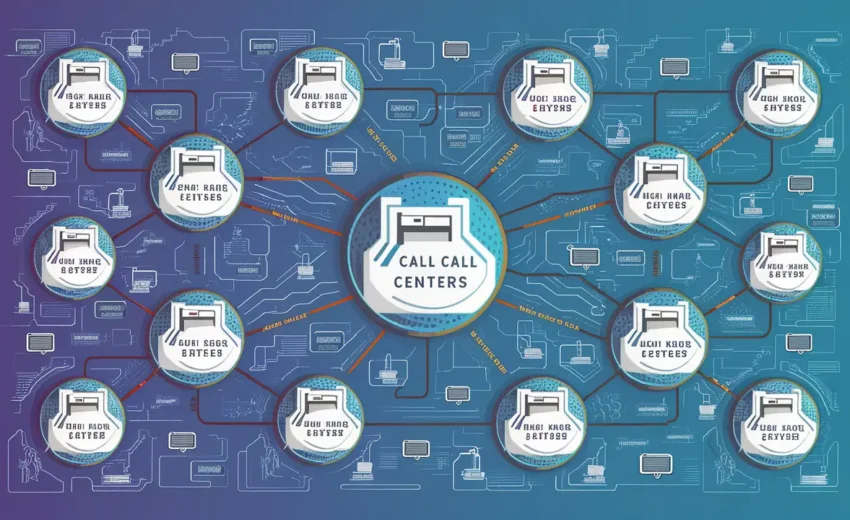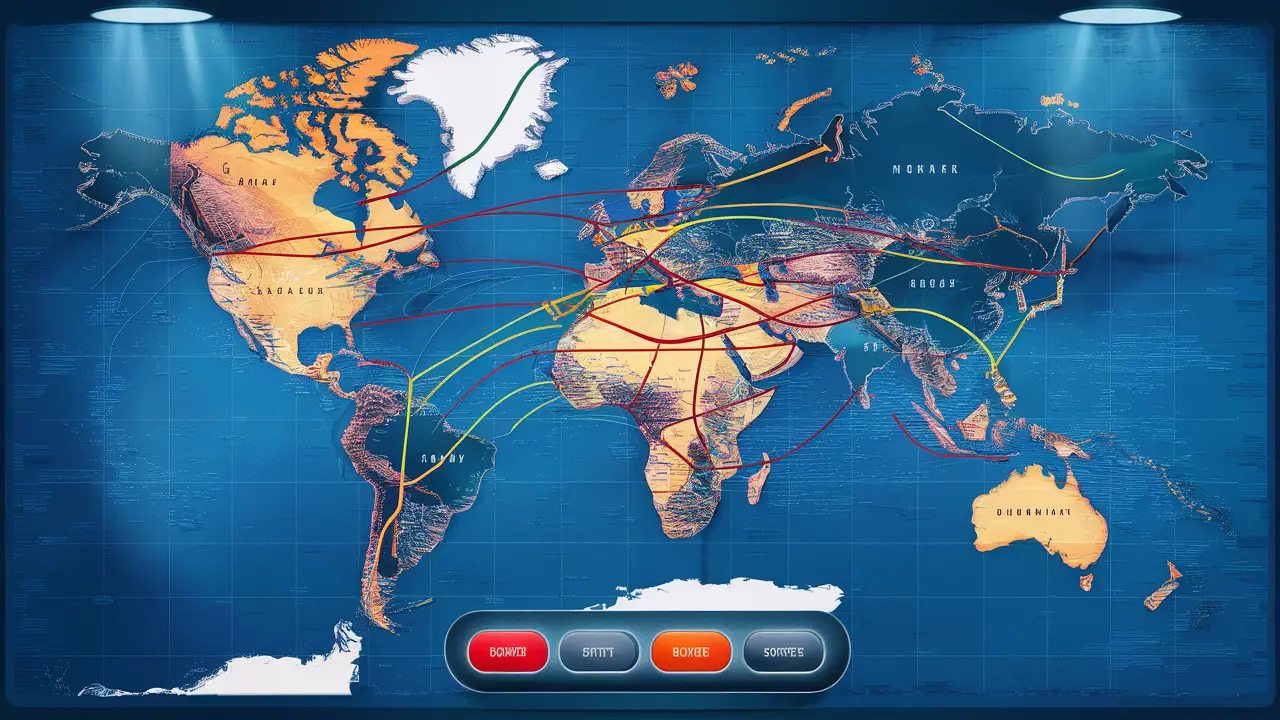
Understanding the Basics of Call Distribution
Have you ever wondered how big companies or customer service centers manage to handle so many calls smoothly? What makes sure your call reaches just the right person or the nearest branch? If these questions spark your curiosity, you’re about to uncover the secrets. Understanding how calls are distributed, especially through location-based routing, will reveal how these seemingly complex systems actually work.
This article will guide you through the basics of call distribution and dive into the specifics of location-based routing. You’ll see how these systems ensure every call is handled swiftly and accurately. We’ll use everyday examples to make things easy to grasp. And if you’re into tech, we’ll connect these ideas to real-world coding, especially using Java and Spring Boot. These are powerful tools often discussed on Blog Rodrigo for building strong call distribution solutions.
 What is Location-Based Routing?
What is Location-Based Routing?
Location-based routing is all about connecting you to the right person for help, based on where you’re calling from. Imagine you’re calling a store, and you get to talk to someone who knows your area well. They might know the local deals or the quickest way to get to the store. That’s the power of location-based routing.
This method is smarter than just sending your call to the next available agent. It uses your location, like your area code or GPS, to find the best person for you to talk to. This means you get help faster and from someone who gets your local needs.
Think about when you’re in New York and need help from a company with locations all over. Without location-based routing, you might end up talking to someone in a completely different state who doesn’t know your local situation. But with this system, your call goes directly to a local agent who understands your area.
The big win here is saving time and improving your experience. You talk to someone who knows what’s going on locally. Businesses also get to use their agents better, making sure the right people are helping the right customers. It’s a win-win situation for everyone involved.
 Real-World Analogy: Connecting Call Distribution to Daily Life
Real-World Analogy: Connecting Call Distribution to Daily Life
Think of location-based routing like a smart GPS for phone calls. When you send a letter, it goes through a system that figures out the quickest way to get it to your friend’s address. That’s exactly how location-based routing works for your calls. It directs your call to the nearest available agent, just like how your letter is sorted and sent to the local post office closest to your friend.
Let’s say you’re calling customer service about a store promotion in your area. If your call is randomly sent to someone far away, they might not know about local deals. But with location-based routing, your call can reach an agent nearby who knows exactly what you’re talking about. This makes your call faster and more helpful.
The goal of location-based routing is simple: connect you with the right person as quickly as possible. Just like how the postal service reduces delivery times by shortening the travel distance, this system minimizes the wait time on calls. It ensures that you talk to someone who understands your local issues.
For businesses, it’s about using resources wisely. Agents handle calls from people in their area, which means they can give better, more accurate help. This boosts customer satisfaction because you get timely and relevant information.
Imagine if every call you made was answered by someone who truly understood your local context. That’s the power of location-based routing. It not only makes your life easier but also helps companies streamline their operations. As technology evolves, these systems will keep getting smarter, ensuring even smoother and more efficient communication.
 Technical Approaches to Implement Location-Based Routing
Technical Approaches to Implement Location-Based Routing
Location-based call routing is like a smart system that connects you to the right person based on where you’re calling from. Imagine it as a GPS for phone calls, making sure you get the help you need as quickly as possible.
This system works by using geolocation algorithms that figure out your location. These algorithms can use different methods, like your IP address or even GPS data from your phone. Once your location is known, the system uses smart routing algorithms to find the best person to handle your call. This means shorter wait times and better help.
- Finding Your Location: The system first needs to know where you’re calling from. It can do this by looking at your IP address, which gives a rough idea of your location. If you’re on a mobile device, it might use GPS for a more accurate position.
- Smart Use of Data: To handle all this location information, the system uses clever data structures like quadtrees or spatial hashing. These tools help quickly find the right agent near you.
- Routing the Call: Once your location is determined, the system uses algorithms like Dijkstra’s to connect you to the closest available agent. This ensures you get the help you need without unnecessary delays.
Think of location-based routing as a tailor-made experience for you. By using these advanced techniques, companies can provide faster and more efficient service. So next time you make a call, remember there’s a smart system working behind the scenes to make sure you get the best support possible.
 Leveraging Java and Spring Boot for Efficient Call Distribution Algorithms
Leveraging Java and Spring Boot for Efficient Call Distribution Algorithms
Creating a system to handle call distribution can seem like a daunting task, but using Java and Spring Boot together can simplify the process. These two technologies are a perfect match for building scalable and efficient systems.
Java is known for being fast and flexible. It can run on nearly any device or operating system, which means your application can work anywhere. This is great for businesses that operate worldwide and need a system that connects calls smoothly, no matter where the customer is located.
On the other hand, Spring Boot makes developing Java applications quicker and easier. It reduces repetitive coding, so you can focus on making your system work better. With Spring Boot, setting up a new project takes less time, which is crucial when quick response times matter.
To illustrate, consider the following example of how to set up a simple RESTful API in Spring Boot to handle incoming calls:
import org.springframework.beans.factory.annotation.Autowired;
import org.springframework.web.bind.annotation.GetMapping;
import org.springframework.web.bind.annotation.RequestParam;
import org.springframework.web.bind.annotation.RestController;
@RestController
public class CallController {
@Autowired
private CallRoutingService callRoutingService;
@GetMapping("/route-call")
public String routeCall(@RequestParam String location) {
return callRoutingService.routeCall(location);
}
}
In this example, we have a controller that receives the caller’s location and uses a service to determine the best agent to route the call to. The routing logic could look something like this:
import org.springframework.stereotype.Service;
@Service
public class CallRoutingService {
public String routeCall(String location) {
// Logic to determine the nearest agent based on location
String nearestAgent = findNearestAgent(location);
return "Call routed to: " + nearestAgent;
}
private String findNearestAgent(String location) {
// Placeholder for actual implementation
return "Agent A in " + location;
}
}
By using Java and Spring Boot, you can build a system that efficiently determines where a customer is calling from and connects them to the nearest available service agent, thus enhancing customer satisfaction.
Spring Boot also supports creating RESTful APIs, adding security, and managing data—all essential for call distribution systems. Features that detect the caller’s location and ensure calls are routed correctly can be seamlessly integrated.
Another benefit is the microservices architecture that Spring Boot supports. This means you can divide the call routing work into smaller, separate parts. Each part can handle different tasks, like detecting location or managing agent availability. For example:
import org.springframework.boot.SpringApplication;@EnableEurekaClient
@SpringBootApplication
public class CallRoutingApplication {
public static void main(String[] args) {
SpringApplication.run(CallRoutingApplication.class, args);
}
}
This setup allows you to maintain an organized system that performs well, even under high call volumes.
In summary, using Java with Spring Boot provides a strong foundation for building call distribution systems. Their combined power not only boosts performance but also makes it easier to adapt to changing customer service needs. This powerful duo helps businesses offer better service and keep customers happy.
Implementing Location-Based Routing in Java: A Step-by-Step Guide
Creating a location-based call routing system in Java can greatly enhance your call distribution effectiveness. It helps direct your customers to the right agents quickly, improving their experience. Here’s a straightforward guide to get you started on building this system.
First, you’ll need to set up your project. Use Spring Boot for this task; it’s perfect for creating RESTful services. Add some helpful dependencies like Spring Web and Spring Data JPA to your project. These tools will be your foundation for handling incoming calls effectively.
Next, you need to define a model for storing location data. This model will include details like latitude, longitude, and area code. Here’s an example:
import javax.persistence.Entity;
import javax.persistence.GeneratedValue;
import javax.persistence.GenerationType;
import javax.persistence.Id;
@Entity
public class Location {
@Id
@GeneratedValue(strategy = GenerationType.IDENTITY)
private Long id;
private double latitude;
private double longitude;
private String areaCode;
// Getters and Setters
}
Then, it’s time to work on a geolocation service. This service will determine the caller’s location, typically using an external API. Here is a simple implementation:
import org.springframework.stereotype.Service;
import org.springframework.web.client.RestTemplate;
@Service
public class GeolocationService {
private final String API_URL = "https://api.ipgeolocation.io/ipgeo?apiKey=YOUR_API_KEY&ip=";
public Location getLocation(String ip) {
RestTemplate restTemplate = new RestTemplate();
return restTemplate.getForObject(API_URL + ip, Location.class);
}
}
}Your call routing logic will sit in its own service. This service will use your database of agents to find the best match for each call. Here’s a basic implementation:
import org.springframework.beans.factory.annotation.Autowired;
import org.springframework.stereotype.Service;
@Service
public class CallRoutingService {
@Autowired
private AgentRepository agentRepository;
public String routeCall(Location location) {
Agent nearestAgent = agentRepository.findNearestAgent(location);
return "Call routed to: " + nearestAgent.getName();
}
}
Don’t forget about creating a model for your agents too. This model should have information like the agent’s name and location details. Here’s an example:
@Entity
public class Agent {
@Id
@GeneratedValue(strategy = GenerationType.IDENTITY)
private Long id;
private String name;
private double latitude;
private double longitude;
// Getters and Setters
}
Finally, set up a controller to manage incoming calls. This controller will use your geolocation and call routing services to determine the best path for each call:
import org.springframework.beans.factory.annotation.Autowired;
import org.springframework.web.bind.annotation.GetMapping;
import org.springframework.web.bind.annotation.RequestParam;
import org.springframework.web.bind.annotation.RestController;
@RestController
public class CallController {
@Autowired
private GeolocationService geolocationService;
@Autowired
private CallRoutingService callRoutingService;
@GetMapping("/route-call")
public String routeCall(@RequestParam String ip) {
Location location = geolocationService.getLocation(ip);
return callRoutingService.routeCall(location);
}
}
Once your system is up and running, test it thoroughly. Use tools like Postman to make sure everything works as expected. Deploy your application to a server and keep an eye on its performance. Make adjustments as needed, based on real-world feedback from users.
Remember, the success of your system lies in its ability to connect callers to the right agents quickly. Keep refining your approach, and as you get comfortable, explore more advanced methods to optimize your routing process even further.
Optimizing Call Distribution in Spring Boot: Essential Strategies
Optimizing call distribution in Spring Boot applications is crucial for enhancing system performance and customer satisfaction. Here are some effective strategies to consider.
One effective method is to implement a caching system to store frequently accessed data, such as the availability of agents. By using a cache like Ehcache or Redis, you can reduce database load and improve response times. Here’s a code snippet demonstrating how to configure a simple caching mechanism with Spring Boot:
import org.springframework.cache.annotation.EnableCaching;
import org.springframework.context.annotation.Configuration;
@Configuration
@EnableCaching
public class CacheConfig {
// Cache configuration
}
Next, you can use caching in your service to store available agents:
import org.springframework.cache.annotation.Cacheable;
import org.springframework.stereotype.Service;
@Service
public class AgentService {
@Cacheable("availableAgents")
public List<Agent> getAvailableAgents() {
// Logic to fetch available agents from the database
return agentRepository.findAvailableAgents();
}
}
Another approach is to handle call routing asynchronously. Using Spring’s @Async functionality allows you to process calls in the background, improving efficiency. Here’s how you can implement asynchronous call routing:
import org.springframework.scheduling.annotation.Async;
import org.springframework.stereotype.Service;
@Service
public class CallRoutingService {
@Async
public CompletableFuture<String> routeCallAsync(Location location) {
// Logic to determine the nearest agent
String nearestAgent = findNearestAgent(location);
return CompletableFuture.completedFuture("Call routed to: " + nearestAgent);
}
}
Load balancing is also essential for optimizing call distribution. You can leverage Spring Cloud LoadBalancer to ensure calls are evenly distributed among agents. Here’s a simple example of how to configure load balancing:
import org.springframework.cloud.loadbalancer.annotation.LoadBalancerClient;
import org.springframework.context.annotation.Configuration;
@Configuration
@LoadBalancerClient(name = "call-service")
public class LoadBalancerConfig {
// Load balancing configuration
}
Monitoring system performance is key. With Spring Boot Actuator, you can gain insights into your application’s health. Here’s how to enable Actuator:
import org.springframework.boot.actuate.autoconfigure.security.servlet.ManagementServerProperties;
import org.springframework.context.annotation.Configuration;
@Configuration
public class ActuatorConfig {
// Actuator configuration can be customized here
}
Finally, testing your system’s performance under high traffic conditions is crucial. Tools like Apache JMeter or Gatling can simulate heavy loads. In your tests, ensure that your call routing logic maintains performance under stress, which can be validated with the following JMeter setup:
Thread Group - Number of Threads: 100 HTTP Request - URL: http://localhost:8080/route-call?ip=192.168.1.1
By implementing these strategies and examples in your Spring Boot application, you can set up an efficient call distribution system that enhances user experience and optimizes resource utilization.
 Challenges and Best Practices in Location-Based Routing
Challenges and Best Practices in Location-Based Routing
Setting up a location-based routing system can be a bit tricky, but understanding the challenges can help you overcome them effectively. Here are some common issues you might face and tips on how to handle them smoothly.
- Data Privacy Concerns: Handling user location data means dealing with sensitive information. You must ensure you’re following rules like GDPR. Always collect only what’s necessary and use strong encryption to protect this data. Regularly check your processes to keep everything safe and build trust with users.
- Accuracy of Location Data: Making sure you have precise location data is vital. If not, calls might not go to the right place, causing frustration. Use different data sources like IP addresses and GPS data from phones to improve accuracy. Keep your data updated for better results.
- System Scalability: As your company grows, your system must handle more traffic without slowing down. Design your system so it can grow with you. Use microservices to break down tasks and make sure everything runs smoothly. Load balancing can also help distribute calls evenly.
- Agent Availability Management: Accurately knowing who’s available to take calls is crucial. If an agent seems free but isn’t, customers wait longer. Use real-time updates to keep track of who’s busy. This helps make the call process efficient.
- Data Integrity and Security: Keeping data accurate and secure is key. Any errors can mess up call routing. Use methods to check data integrity and ensure only the right people can access sensitive information. This keeps your system reliable.
Challenges are part of implementing a location-based routing system, but with the right strategies, you can overcome them. Your main goal should be to provide efficient and secure call routing while protecting user data.
Conclusion: Mastering Location-Based Routing for Enhanced Call Distribution
At this point, you’ve discovered the critical role that location-based routing plays in ensuring that calls are directed to the right person at the right time. This innovative approach not only enhances customer satisfaction but also streamlines operational efficiency, making it a vital strategy for any business.
For those engaged with projects like Blog Rodrigo, this guide serves as a comprehensive resource for leveraging Java and Spring Boot in creating sophisticated systems centered on intelligent call distribution. The practical insights and techniques outlined here can significantly impact your development process.
As you conclude your exploration, consider how you can implement these strategies in your own work. Reflect on the importance of connecting customers with the most suitable agents and think about actionable steps you can take to enhance your call distribution systems. To further enrich your understanding, delve into the recommended resources and explore advanced concepts in call routing technology. Your journey toward creating exceptional customer experiences starts now!






